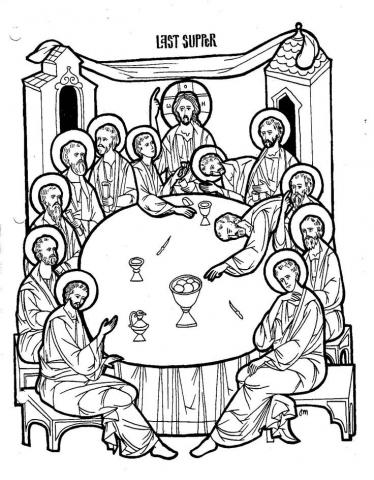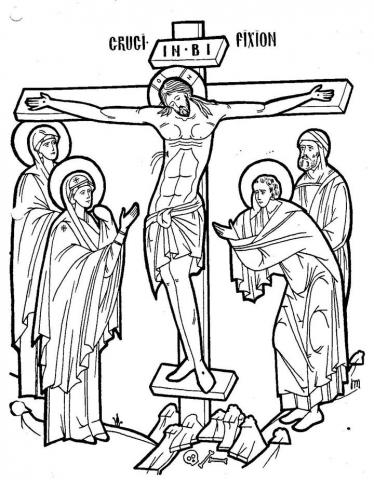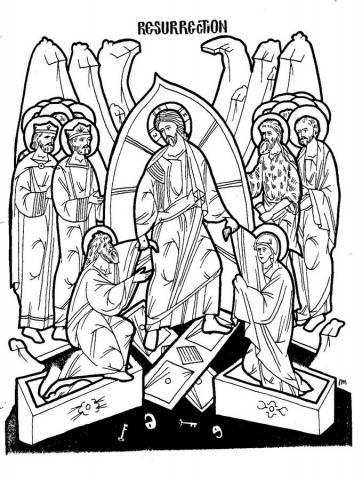Pascha
PASCHA, THE FEAST OF FEASTS
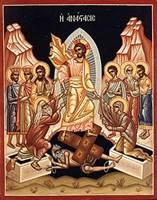 Objectives:
Objectives:
- Students should understand the icon, its characters and its significance.
- Students should know the Troparion of the feast and “Christ is risen…”
- Students should know the Paschal greeting and response, preferably in several languages.
Possible Lesson Plan:
- Open with prayer.
2. The icon: again begin with its review and discussion. Christ is the central figure, robed in white (Why?) surrounded by light (Why?), at His feet are the brass gates of Hades, the keys, and the locks that He destroyed. Adam is being pulled from his tomb by Christ with His right hand and Eve with His left. The righteous from the Old Testament gather on the left; the 2 in the front are Kings David and Solomon. The righteous from the New Testament are those on the right, those who died after the Incarnation and before the resurrection; in front we find St. John the Baptist and St. Joseph.
3. Scripture readings:
Gospel: John 1:1-17, Matthew 28
Epistle: Acts 1:1-8, Romans 6:3-11
Old Testament: Ezekiel 37:1-14, Exodus 12:1-11, Daniel 3:1-88, review the story of Jonah
- Songs of the Feast:
Troparion: Thy resurrection, O Christ our Savior, the angels in heaven sing, enable us on earth to glorify thee in purity of heart.
Another Troparion: Christ is risen from the dead, trampling down death by death, and upon those in the tombs bestowing life!
Kontakion: Though thou, O deathless One, didst descend into the grave, thou didst destroy the power of hell and, as victor, thou didst rise again, O Christ our God. Thou didst greet the ointment-bearing women, saying, Rejoice! Thou didst bestow peace upon thy Disciples, and resurrection upon those that are fallen.
Megalynarion: The angel cried to the Lady full of grace, Rejoice, O pure Virgin. Again I say: Rejoice. Your Son is risen from his three days in the tomb. With himself he has raised all the dead. Rejoice, all ye people. Shine! Shine! O new Jerusalem! The glory of the Lord has shone on you. Exult now and be glad, O Zion! Be radiant, O pure Theotokos, in the resurrection of your Son.
- Review the chronology of Holy Week (put the events on cards and have the students place them on a time line?) and the major players:
Jesus, the 12 disciples (who were they?), myrrh-bearing women (though they haven’t brought the myrrh year, who will they be?), the Pharisees (a group of religious leaders of the Jews particularly devoted to the Torah), the Sadducees (a wealthy priestly aristocracy, concerned with Temple administration and ritual), the scribes (educated civil servants), the Sanhedrin (a senate of 70 priests and laymen, presided over by the high priest), Caiaphas the High Priest, Pontius Pilate the Roman governor, Herod the King, Barabbas the condemned murderer, the 2 thieves, the centurion (the same one who had early sough Jesus out for healing of his servant according to tradition), and Joseph of Arimathea (a wealthy follower of Jesus and member of the Sanhedrin, “the noble Joseph”).
Holy Monday: Teaching in the temple (parable of the wedding banquet), questioned by the priests: Some sample questions were “By whose authority are You doing these things?” and “Is it lawful to pay taxes to Caesar?” Read in Matthew 21 and 22 Jesus’s clever answers.
Holy Tuesday: teaching again, many parables about the kingdom, including the talents, the foolish virgins, the sheep and goats at the Last Judgment.
Holy Wednesday: Anointing of Jesus at the home of Simon the leper (therefore the church custom of anointing with oil this evening) and betrayal by Judas Iscariot to the chief priests for 30 pieces of silver.
Holy Thursday: Arrangements for the upper room, washing of the disciples’ feet, the Last Supper, the prayer in the Garden of Gethsemane, the betrayal by a kiss in the garden, the trial before the Sanhedrin. How do we celebrate Holy Thursday? Why the last Eucharist (before Pascha)? Listen closely to the 12 gospel readings on Holy Thursday night; they tell the entire story of Holy Week.
Great and Holy Friday: denial by Peter, suicide by hanging of Judas, trials before Pilate, Herod, and Pilate, crucifixion, and burial by the noble Joseph of Arimathea. What did Jesus say from the cross? (You’ll have to look in all of the Gospels to find all the sayings.) How do we celebrate Holy Friday? Why the bier and funeral procession?
Great and Holy Saturday: Descent into Hades and victory over death! Why are the vestments, candles, and altar pieces changed to white?
Pascha: Resurrection! The Church is in darkness. Light spreads to all from the Trikirion, the 3 in 1 candle representing the Trinity. We process around the church like the myrrh-bearing women walking to the tomb. Eggs represent new life. We greet each other with:
English: Christ is risen! Indeed He is risen!
Greek: Christos anesti! Alethos anesti!
Russian: Christos voskrese! Voistinu voskrese!
Arabic: Al-masi-kam! Haq an qaam!
Romanian: Christos inviat! Adeverat inviat!
6. Discussion questions:
Why is the resurrection considered the central truth of Christianity? (Read I Cor. 15:13-19) How is this different from other religions? Was the resurrection a hoax perpetrated by the disciples? (Would each of them later die for what they knew to be a lie?) Or did the authorities move the body? (But why didn’t they then display it to the public when the disciples claimed He had risen and thus prove He was still dead?) Or did Jesus never actually die at all, but just faint? (All contemporary accounts, even those of the Jewish and Roman authorities of the time, agree that He most certainly died.) Did the apostles all have identical “hallucinations” after His death of His appearances? (Be realistic – all 500 who saw Him at 10 distinct times and places! Can you identify some of His appearances – e.g. upper room, Sea of Galilee, road to Emmaeus, Ascension, etc? What about doubting Thomas? Hallucinations usually involve seeing things one really wants to see, not being convinced against one’s will!)
What Old Testament characters/stories are referenced in the canon and why? (“the inspired prophet Habakkuk”, “David the ancester of God leaped and danced before the ark which prefigured thee”, “like Jonah from the whale on the third day you arose from the grave”, “resurrecting Adam the father of us all”, “He who saved the three young men from the furnace became incarnate and suffered as a mortal man”)
Whose homily is always read? (St. John Chrysostom) What is its theme? (Review the parable of the laborers in the vineyard; did those who arrived on the first hour receive a better reward than those who arrived at the eleventh hour? “O death where is thy sting? O Hades, where is thy victory? Christ is risen and thou art annihilated…”)
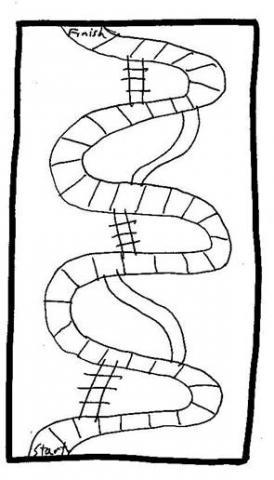
- Make a Holy Week Game: Each student
should get a piece of poster board about
12x24 inches. Ahead of time, draw on
each board a zigzag pathway like in
“Snakes and Ladders”. Have students
write the incidents of Holy Week,
beginning with Palm Sunday, on the
board; good events (like Palm Sunday
and the Last Supper) get a ladder (Who
in the Bible saw a ladder to heaven?),
while sad events get a snake (Who does
the snake represent?) Play the game,
if there’s time, or take it home to play
with parents and siblings.
- Make a felt banner as before. Here are some ideas:
- Close with prayer.
